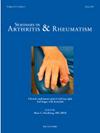SGLT2抑制剂治疗系统性红斑狼疮患者的肾脏预后:一项国家队列研究
IF 4.4
2区 医学
Q1 RHEUMATOLOGY
引用次数: 0
摘要
目的评估SGLT2抑制剂对系统性红斑狼疮(SLE)患者肾小球滤过率(eGFR)随时间的影响。方法:本研究采用Clalit Health Services SLE registry (CHS-SLE registry)对4354例SLE患者进行回顾性分析。我们对2015年至2022年间开始使用SGLT2抑制剂的SLE患者进行了两步倾向评分匹配分析。主要终点是24个月时的eGFR。我们还评估了SGLT2抑制剂使用者与非使用者的无事件概率,包括eGFR快速下降、eGFR下降≥30%、新发终末期肾病(ESKD),以及24个月时这些结果的综合。此外,我们对eGFR变化进行了亚组分析,按基线患者特征分层。结果基线时,260名SGLT2抑制剂使用者与413名非使用者配对。两组配对后的基线eGFR相似(71.0 vs. 70.0 mL/min/1.73 m²,p = 0.7)。24个月时,SGLT2抑制剂使用组的eGFR为71.2 mL/min/1.73 m²(95% CI 69.1-74.9),非使用组的eGFR为65.4 mL/min/1.73 m²(95% CI 62.5-68.4) (p <;0.001)。使用SGLT2抑制剂可降低发生eGFR快速下降的风险(HR 0.74, 95% CI 0.59-0.92, p = 0.01),降低发生复合结局的风险(HR 0.72, 95% CI 0.53-0.97, p = 0.03)。结论:在SLE患者中,暴露于SGLT2抑制剂与改善肾功能和降低发生不良肾脏结局的风险相关。本文章由计算机程序翻译,如有差异,请以英文原文为准。
Kidney outcomes of systemic lupus erythematosus patients treated with SGLT2 inhibitors: A national cohort study
Objectives
To evaluate the impact of SGLT2 inhibitors on the estimated glomerular filtration rate (eGFR) over time in patients with systemic lupus erythematosus (SLE).
Methods
This was a retrospective real-world analysis using the Clalit Health Services SLE registry (CHS-SLE registry), a national cohort of 4354 SLE patients. We conducted a two-step propensity-score matching analysis of SLE patients who initiated SGLT2 inhibitors between 2015 and 2022. The primary outcome was the eGFR at 24 months. We also assessed the event-free probability for SGLT2 inhibitor users versus non-users regarding a rapid decline in eGFR, ≥30 % eGFR decline, new-onset end-stage kidney disease (ESKD), and a composite of these outcomes at 24 months. Additionally, we performed subgroup analyses of eGFR changes stratified by baseline patient characteristics.
Results
At baseline, 260 SGLT2 inhibitor users were matched with 413 non-users. The baseline eGFR after matching was similar between the two groups (71.0 vs. 70.0 mL/min/1.73 m², p = 0.7). At 24 months, the eGFR was 71.2 mL/min/1.73 m² (95 % CI 69.1–74.9) in the SGLT2 inhibitor users and 65.4 mL/min/1.73 m² (95 % CI 62.5–68.4) in the non-user group (p < 0.001). The use of SGLT2 inhibitors was associated with a reduced risk of developing a rapid decline in eGFR (HR 0.74, 95 % CI 0.59–0.92, p = 0.01), and a reduced risk of developing the composite outcome (HR 0.72, 95 % CI 0.53–0.97, p = 0.03).
Conclusions
In SLE patients, exposure to SGLT2 inhibitors was associated with improved kidney function and a reduced risk of developing adverse kidney outcomes.
求助全文
通过发布文献求助,成功后即可免费获取论文全文。
去求助
来源期刊
CiteScore
9.20
自引率
4.00%
发文量
176
审稿时长
46 days
期刊介绍:
Seminars in Arthritis and Rheumatism provides access to the highest-quality clinical, therapeutic and translational research about arthritis, rheumatology and musculoskeletal disorders that affect the joints and connective tissue. Each bimonthly issue includes articles giving you the latest diagnostic criteria, consensus statements, systematic reviews and meta-analyses as well as clinical and translational research studies. Read this journal for the latest groundbreaking research and to gain insights from scientists and clinicians on the management and treatment of musculoskeletal and autoimmune rheumatologic diseases. The journal is of interest to rheumatologists, orthopedic surgeons, internal medicine physicians, immunologists and specialists in bone and mineral metabolism.

 求助内容:
求助内容: 应助结果提醒方式:
应助结果提醒方式:


